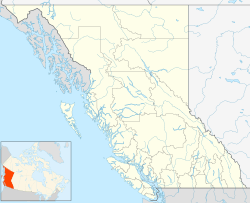Port Essington, British Columbia facts for kids
Quick facts for kids
Port Essington, British Columbia
|
|
|---|---|

Port Essington 1915
|
|
| Country | |
| Province | BC/BCE |
| District | Skeena-Queen Charlotte Regional District |
| Founded | 1871 |
| Population
(2008)
|
|
| • Total | 0 |
| • Estimate
(Peak)
|
1,000 |
Port Essington was once a busy town in northwestern British Columbia, Canada. It was located where the Skeena River and Ecstall River meet. This spot is between the cities of Prince Rupert and Terrace.
The town was started in 1871 by two men, Robert Cunningham and Thomas Hankin. For a while, it was the biggest settlement in that whole area. Many different people lived there, including European-Canadians, Japanese-Canadians, and First Nations people. Many Tsimshian people from the Kitselas and Kitsumkalum tribes called Port Essington home.
In the Tsimshian language, the area was known as Spaksuut or "Spokeshute". This name means "autumn camping place". It also became the Tsimshian name for the town. Even Spokeshute Mountain, which stands behind the community, got its name from this word. The town was built on the traditional land of the Gitzaxłaał tribe. They are one of the nine Tsimshian tribes from Lax Kw'alaams. In 1888, a famous anthropologist named Franz Boas visited Port Essington. He talked to Haida and Tsimshian people. He also started working with Odille Morison, a Tsimshian language expert who lived in the town.
Contents
The Story of Port Essington
How the Town Began
In 1871, many people were rushing to find gold in the Omineca Gold Rush. One way to reach the goldfields was by traveling up the Skeena River to Hazelton. From there, people would go overland to Babine Lake and then to the Omineca River.
The government gave Robert Cunningham and Thomas Hankin permission to build a toll road from Hazelton to Babine Lake. A man named William Moore was in charge of using pack mules on this trail. Cunningham and Hankin claimed land on the south bank of the Skeena River. They set aside some land for the local First Nations. The rest of the land was divided into smaller pieces and sold to settlers.
Growth and Industry
The Hudson's Bay Company bought three pieces of land that summer. They built a store there, which became known as the Skeena Post. In 1876, the first salmon cannery was built. By the early 1900s, there were seven canneries near the river's mouth.
Robert Cunningham also built a hotel and a town hall. He even built the first cold storage plant in the north, which opened in 1892. The town had a lively social scene with dances, concerts, and church events. There were also three hotels.
Life in Port Essington
Even though the town seemed busy, its economy changed with the seasons. Salmon fishing happened mostly in the summer. The river was closed for shipping goods in the winter. Because of this, many people would move south each fall. In the early 1900s, Port Essington's population could be around 1,000 people. But in the winter, it would drop to about a quarter of that.
The town faced tough times with fires. In 1899, a fire almost destroyed everything, leaving only one building. Then, in January 1909, another fire caused a lot of damage.
Decline and Ghost Town Status
Port Essington started to lose its importance when the Grand Trunk Pacific Railway was finished in 1914. This railway ran along the opposite bank of the Skeena River. Trains began to replace the riverboats that had been the main way to transport goods. This change hurt the town's economy.
By the 1940s, all of Port Essington's canneries were no longer working. In the 1950s, the number of people living there dropped sharply. More fires in 1961 and 1965 burned down much of what was left. Today, Port Essington is a ghost town. Even though it still appears on some maps, no one lives there anymore.
The land where Port Essington once stood is now an Indian reserve. It is managed by the Kitselas and Kitsumkalum bands together. There are now efforts to turn the remains of Port Essington into a place for tourists to visit.
Captain Vancouver named the area after Sir William Essington.
Notable People from Port Essington
- Robert Cunningham, a businessman who helped found the town.
- Odille Morison, a Native linguist who worked with Franz Boas.
- William Henry Pierce, a missionary and writer.
- Walter Wright, a hereditary chief and a keeper of oral history.


